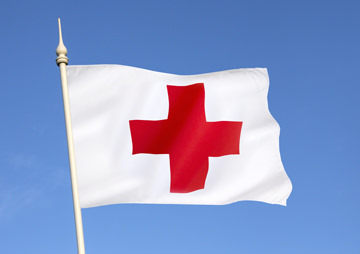Red Cross Demands Corrections to ‘Misleading’ Coverage. Here’s Journalists’ Response
The American Red Cross recently sent ProPublica and NPR a request for corrections to our series of stories about the charity's failures in responding to Hurricane Isaac and Superstorm Sandy, misleading donors about how money is spent, and other issues. Shutterstock
Shutterstock
By Justin Elliott and Jesse Eisinger, ProPublica, and Laura Sullivan, NPRThis piece originally ran on ProPublica.
The American Red Cross recently sent ProPublica and NPR a request for corrections to our series of stories about the charity’s failures in responding to Hurricane Isaac and Superstorm Sandy, misleading donors about how money is spent, and other issues. We stand by our reporting and have found no instances of errors. We have responded in detail below, noting where the Red Cross’ assertions are misleading or incorrect.
The organization’s request for corrections came shortly after we sent questions related to our ongoing reporting, specifically about the Red Cross’ response to the 2010 Haiti earthquake.
Our stories have been scrupulously fair to the Red Cross. The Red Cross had an opportunity to respond to every fact, detail, and allegation from our reporting before every story. Before the stories ran, we sent the Red Cross extensive and detailed questions, documents and had in-person interviews with officials. We took the charity’s responses seriously and modified our stories based on the Red Cross’ responses.
Our core conclusions about the Red Cross’ response to Sandy and Isaac were drawn from the charity’s own high-level internal assessments. We posted those documents.
We also interviewed dozens of Red Cross officials and volunteers, storm victims, and government officials.
Below, we have summarized the charity’s complaints about our coverage, followed by our responses. (Here are the Red Cross’ criticisms in full.)
1. Emergency response vehicles diverted for PR purposes
Red Cross complaint (pg. 1):
The charity takes issue with our reporting that executives diverted vehicles for public relations purposes. In particular, the Red Cross asserts that NPR’s version of the story erroneously refers to multiple “incidents” where 40 percent of available emergency response vehicles were used for press conferences. The Red Cross also says our reporting relied on a “lone source.” It both denies that any emergency vehicles were diverted away from providing relief and says that the 40 percent figure is wrong.
Our response:
The Red Cross’ claim that we referred to multiple “incidents” where 40 percent of vehicles were diverted is based on its use of a misleading, truncated quotation.
NPR’s transcript makes clear the word “incidents” refers to a variety of episodes, not just the diversion of trucks:
Our reporting found incidents where the charity sent as many as 40 percent of its emergency vehicles to press conferences instead of into the field, where it failed to show up as promised to open shelters, allowed sex offenders to hang out in a shelter’s play area.
As for the Red Cross’ claim that our account was based on a single source, that is false.
The account of the Red Cross’ use of its vehicles for public relations purposes was based on interviews with multiple Red Cross officials and volunteers, including two current Red Cross senior managers. Their accounts were bolstered by internal documents and two contemporaneous emails, one to senior Red Cross officials at the time and another a month later to Red Cross disaster volunteers.
After our story published, we were contacted by a Red Cross driver who received orders to stop delivering goods to storm victims and instead show up at the press conference cited in the story with Red Cross President Gail McGovern.
“The press conference did keep us from being able to provide any meaningful response that day,” the driver told us.
Another Red Cross official at the event told us, “The only purpose for sending the ERVs there was to show a large presence. The vehicles were told where to park, which was behind where the podium was set up,” the official said. “They were not providing services there.”
All of those first-hand accounts are in line with the Red Cross’ own Lessons Learned PowerPoint presentation, produced out of national headquarters in Washington, which lists “diverting assets for public relations purposes” as a “hindrance to service delivery.”
As for the Red Cross’ claim that even if vehicles were diverted, it wasn’t 40 percent of them: In supporting its point, the group cites a “disaster log” showing a count of emergency response vehicles assigned during Sandy in New York state overall. It is not a log of the vehicles available in the relevant area, New York City. We asked Red Cross officials for that information before publication and they have declined to provide it.
2. Hurricane Isaac volunteers sent where they weren’t needed
Red Cross complaint (pg. 3):
The charity disputes our reporting that the vast majority of Red Cross responders deployed in advance of Hurricane Isaac in 2012 were stationed in Tampa, Florida – site of the Republican National Convention — even after it became clear the storm would not hit there.
“Again, this is the opinion of one Red Cross worker, unsubstantiated by the facts,” the Red Cross writes.
Our response:
While the Red Cross insists Tampa was under threat, the National Hurricane Center disagrees. As of Friday, Aug. 24, 2012, which was five days before landfall, Tampa was not under a hurricane threat or warning.
Five days out “it was clear the center of the storm would pass well to the west of Tampa,” Dennis Feltgen of the National Hurricane Center told us.
During the period that the Red Cross was stationing around 500 people in Tampa, a hurricane watch was under way for Mississippi, Louisiana and Alabama. Multiple people, including Red Cross volunteers and staffers, told ProPublica and NPR that the organization had difficulty moving people out of Tampa.
In our story, we noted that the Red Cross responded to our questions about Tampa by saying that “the volunteers and resources we deployed to Florida did not come at the expense of other states.” We wrote that the charity “did not provide figures for how many mass care volunteers were on the ground in other states before Isaac.” This is accurate.
ProPublica and NPR repeatedly asked the Red Cross for the number of volunteers on the ground in states other than Florida before Isaac. In response to those questions, the Red Cross gave us the number of “personnel” who were “assigned and deployed” after the storm. Those who are “assigned and deployed” are not necessarily on the ground, as the Red Cross concedes.
3. Failures in Bergen County, New Jersey
Red Cross complaint (pg. 4):
The charity takes issue with our reporting that the Red Cross’ response to Sandy was particularly inadequate in Bergen County, New Jersey. The Red Cross says we ignored “positive comments about the Red Cross while pretending only negative comments exist.”
Our response:
The Red Cross is not disputing the fact at the center of our reference to Bergen County: That the charity did not show up at the county’s Emergency Operations Center. “They were the only major player not there,” police lieutenant and Bergen County Emergency Management Coordinator Matthew Tiedemann told us.
Tiedemann’s detailed, on-the-record, first-hand account was confirmed by a second Bergen County officer.
The Red Cross claims it “offered to staff” the Emergency Operations Center in Bergen County but that its offer was declined. We checked that before publication with Tiedemann.
“That’s totally untrue,” he told us in a previously unpublished interview. “We did not say they didn’t need to staff it. Everyone needs to be in the EOC.”
Further, Tiedemann told us that after we had sent inquiries to the Red Cross but before the story was published, an official from the group reached out to him and said, “We’ll fix everything.” Tiedemann says he told the official: “Sorry, I already talked to them and told them the truth.”
Red Cross spokeswoman Suzy DeFrancis acknowledged to us in a statement before publication the Red Cross “had communications issues with the Bergen County officials during the early days of Sandy, and we will continue to address these.”
We did not include the quotes the Red Cross provided from New Jersey state officials because they came from political appointees with no apparent knowledge of what happened in Bergen County in the days following Sandy.
4. Questioning the standing of a key source
Red Cross complaint (pg. 5):
The charity says “much of the criticism” in our stories came from one source, whose role we inflated.
Our response:
Again, the central conclusions of our coverage were drawn from the American Red Cross’ own internal high-level assessments, including minutes of a meeting with Red Cross executives in Washington.
The source whose standing the charity questions, Richard Rieckenberg, was one of the Red Cross’ top disaster specialists. He was the Mass Care Planning Chief or Mass Care Chief for 27 of the nation’s worst disasters over the course of seven years. “Mass Care” is the term for feeding, sheltering, and providing emergency supplies after a disaster, the job the Red Cross is most known for. Before Sandy hit, Rieckenberg worked out of national headquarters in Washington, D.C. as the Mass Care Planning Chief and then took over as a senior Mass Care official in New York after the storm passed. Both of those roles gave him a perspective on the Red Cross’ efforts on the ground and in its overarching response..
Just a month earlier, the Red Cross’ current vice president for disaster operations praised Rieckenberg as “an extraordinary asset to the country.“
5. The Red Cross wasted large amounts of food
Red Cross complaint (pg. 6):
The charity says our reference to the Red Cross wasting food was based on a single Red Cross responder, specifically Richard Rieckenberg.
Our response:
Our story noted that Rieckenberg estimated that the Red Cross wasted 30 percent of its food in the early days after Sandy — and we also noted the Red Cross disputed the figure. As we reported, the Red Cross’ own internal documents also found that food waste was “excessive” because of “kitchen manager inexperience,” “political pressures,” and “poor communication.”
We repeatedly gave the Red Cross an opportunity to furnish an estimate of wasted meals. It never has.
6. Empty trucks sent around just to be seen
Red Cross complaint (pg. 6):
The charity disputes our reporting that the Red Cross sent around empty trucks after Hurricane Isaac just to be seen. In particular, the Red Cross writes, “There is no evidence to support this other than the recollection, again, of Rick Rieckenberg.”
Our response:
The Red Cross is wrong.
We have three sources with first-hand knowledge of the Red Cross sending around empty trucks after Isaac just to be seen: Rieckenberg, who was on the scene, noted that volunteers “were told to drive around and look like you’re giving disaster relief;” another Red Cross official who was on the scene corroborated this account (that official was not quoted in the story); as did Jim Dunham, one of the Red Cross drivers ordered to drive around.
“We were sent way down on the Gulf with nothing to give,” Dunham told us. The Red Cross’ relief effort was “worse than the storm.”
7. Red Cross CEO Gail McGovern has serially misled donors
Red Cross complaint (pg. 7):
The charity disputes that it has been misleading donors about how money is spent.
Our response:
The Red Cross is not alleging a factual error in ProPublica and NPR’s reports that the Red Cross has long falsely claimed that 91 cents of every dollar donated is spent on services.
The Red Cross repeated this erroneous claim in annual reports, on its website and in multiple speeches, including at least four speeches and written statements by CEO Gail McGovern.
After inquiries by ProPublica and NPR, the Red Cross removed the statement from its website. It acknowledged the claim was not “as clear as it could have been, and we are clarifying the language.”
8. Refusing to work with Occupy Sandy
Red Cross complaint (pg. 8):
The charity denies our reporting that after Sandy Red Cross executives told staffers not to work with the well-regarded group Occupy Sandy out of concern over the connections to the Occupy Wall Street protest movement.
Our response:
Our story about the Red Cross and Occupy Sandy is clear: In the early period after the storm multiple Red Cross workers were told by superiors not to work with Occupy Sandy. This was not only the time of greatest need but also when a partnership with the more nimble Occupy group could have benefitted the Red Cross’ slow-moving efforts.
Here are our sources for the prohibition, as we laid out in the story: interviews with three Red Cross responders with first-hand knowledge of the ban; interviews with Occupy Sandy volunteers; and a Department of Homeland Security-sponsored study that also cites a prohibition. In that study, a Red Cross chief of volunteer coordination who oversaw 25 workers recalled that “he was told not to work with Occupy Sandy because of the affiliation with [Occupy Wall Street].”
The DHS-sponsored study does not offer “an alternative” view, as the Red Cross claims. It merely cites examples of the Red Cross working with Occupy Sandy, which happened either in spite of the early ban or after it was lifted. The point of the story — and the reason our Red Cross sources were frustrated by the politically driven policy — was that if these partnerships had been allowed to occur earlier, storm victims would have benefitted.
The Red Cross writes that our story “shockingly fails to note the balanced picture that emerges from comments such as these on pp. 40 and 41 [of the study]” including the sentence “Occupy Sandy described the American Red Cross as ‘being our lifeline for hot meals.'”
In fact, that exact quote is included in our story as an example of fruitful cooperation.
9. Senator probes Red Cross finances
Red Cross complaint (pg. 9):
The charity objects to various characterizations of Sen. Charles Grassley’s inquiries into its finances. They call our headline “hyper-extended.”
Our response:
The Red Cross is not alleging a factual error. Following our story on CEO Gail McGovern misstating how donor dollars are spent on services and overhead, Grassley announced: “The public’s expectation for an important, well-known organization like the Red Cross is complete, accurate fundraising and spending information. In reaction to the news reports on this topic, I’m asking the Red Cross to elaborate on how it calculates the facts and figures given to the donating public.”
Investigative staffers for the senator met with the group and asked for documents and a detailed breakdown of the charity’s finances.
10. Difficulty of finding sources who praised the Red Cross
Red Cross complaint (pg. 10):
The charity disputes a comment by one of us on a Reddit chat that it was difficult to find sources who had positive things to say about the Red Cross’ response to Isaac and Sandy. The charity also complains that we did not include a survey it provided of those who received Red Cross help after Sandy.
Our response:
Our answer on our Reddit chat was: We “interviewed dozens of people, including many Red Cross officials and volunteers, storm victims, and government officials. It was very difficult to find sources with positive things to say about the Red Cross’ responses to Sandy and Isaac. More importantly, multiple sources confirmed and fleshed out the Red Cross’ own conclusions from its internal assessments.”
This is accurate. In our dozens of interviews it was quite rare to hear positive assessments of the Red Cross’ storm responses from people who do not currently work for the Red Cross’ public affairs office.
In fact, we did not include in our story many of the negative experiences we heard about the Red Cross.
For example, the Red Cross writes in its complaint that “the reporters spoke with the Head of the Mississippi office of Emergency Management, who discussed our response to Isaac in what we understand was positive terms, and none of that was included.”
It’s accurate that ProPublica reporter Justin Elliott interviewed Robert Latham, executive director of the Mississippi Emergency Management Agency. But Latham was quite critical of the Red Cross’ response. Echoing others we interviewed, Latham told us that the Red Cross’ reorganizations had alienated experienced disaster responders, contributing to an anemic Isaac response.
“They really ran off a lot of their good people,” Latham said in our interview. “I had gotten to that point where I finally told the Red Cross, ‘When you get through reengineering or whatever it is you’re doing, you come see me.'”
Regarding the Red Cross’ survey of “clients,” as we explained to the Red Cross in November, we asked several data experts to look closely at the survey and they told us that it was not a representative sample.
It was not a survey of people representing a broad cross section that were affected by Sandy, as the Red Cross claimed. In the case of the New Jersey survey, for example, the survey pool was several thousand people who stayed in a Red Cross shelter. A key problem with the Red Cross response to the storm was its failure to help more victims; those people were not surveyed.
If you have information about or experience with the Red Cross, particularly with the charity’s work in Haiti, email [email protected].
ProPublica is a Pulitzer Prize-winning investigative newsroom. Sign up for their newsletter.
Your support matters…Independent journalism is under threat and overshadowed by heavily funded mainstream media.
You can help level the playing field. Become a member.
Your tax-deductible contribution keeps us digging beneath the headlines to give you thought-provoking, investigative reporting and analysis that unearths what's really happening- without compromise.
Give today to support our courageous, independent journalists.









You need to be a supporter to comment.
There are currently no responses to this article.
Be the first to respond.